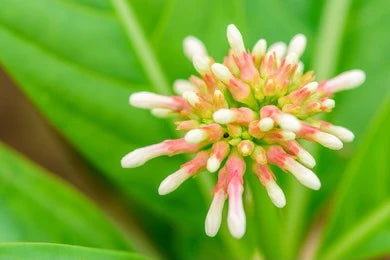The erect, glabrous, perennial sarpagandha plant is an evergreen shrub that typically reaches a height of 60 cm. Rauwolfia Serpentina is the scientific name for sarpagandha. This herb has tuberous roots with a light brown cork.
This plant often produces whorls of three leaves, which are pale green below and brilliant green above. The leaf bases are tapered and narrow in shape. This plant has lengthy petioles.
Nectar is present in the deepest part of the corolla tubes of the white, occasionally violet, flowers. The pedicles are sturdy and the peduncles are sufficiently lengthy. The calyx has a vivid red hue. Typically, the corolla is longer than the calyx. This plant produces ovoid, somewhat connate, purplish-black drupes. In India, this plant flowers from March to May. Its tiny, oval-shaped, juicy fruits mature into lustrous, purple-black fruits.
General Description
The therapeutic efficacy of Rauwolfia serpentina has long been recognized. It is one of the best treatments for high blood pressure and is also used as a sedative and tranquilizer.
Rauwolfia serpentina is a complex mixture of over fifty distinct alkaloids and other bioactive compounds. Ajmaline, ajmalicine, indobine, indobinine, ajmalimine, serpentine, serpentinine, deserpidine, reserpinine, reserpiline, rescinnamine, yohimbine, and yohimbinine are the primary alkaloids out of 50 that are found. One of this plant's relatively helpful alkaloids is serpine. The plant's tuberous roots contain around 90% of these alkaloids.
Classification
- Kingdom: Plantae
- Division: Magnoliophyta
- Class: Magnoliopsida
- Order: Gentianales
- Family: Apocynaceae
- Genus: Rauwolfia
- Species: Serpentina
Habitat
This plant grows in Thailand as well as in India, Pakistan, Sri Lanka, and Burma. It is found throughout the sub-Himalayan region of India, extending from Punjab to Nepal, Sikkim, and Bhutan. It is also found in the Andaman, Eastern, and Western Ghats, as well as the lower hills of the Gangetic plains. It can be found in shaded spots and damp deciduous forests up to 4,000 feet above sea level in India. This plant never grows in one area in large quantities. To put it briefly, it is widely grown throughout much of India.
Another name of Sarpagandha
- English Name - Rauwolfia root, serpentine root, Sepentina root, Indian snakeroot.
- Hindi Name - Nkulkanda, Rasnabhed, Chota chand, Hrakai chand, Nayi, Nakulikand
- Kannada Name - Chandrika, Sutranabhi, Patala garuda, Sarpagandhi
- Bihari Name - Sanachando, Isargaj, Chandmarua, Dhanmarua, Dhanbarua, Dhavalbarua
- Telugu name - Patalagaruda, Patalagandhi, Padagpuchahv, Dumparasna, Patala Garuda, Patalagani.
- Bengali Name - Chandra Nolbel ,Gandrasana, Sugandhanakuli, Chandar, Nakuli, Chotachand
- Marathi Name - Harki, Sapasanda, Adkayi, Adakayi, Chotachand
- Gujarati Name - Amelpadi, Norbal, Amelpodi
- Tamil Name - Savannamibori, Covanna milpori, Sarppaganti, Civan amal podi, Carpakanta, Covanna Milpadi, Sivan amalpodi.
- Malayalam Name - Tullunni, Chuvanna avilpori, Chuvanna amalpari, Amalpori, Chivan amalpodi, Civan amalpadi Chivan Avalpori.
Ayurvedic Properties
|
|
Hindi / Sanskrit |
English |
|
Rasa (Taste) |
Tikta |
Bitter |
|
Guna (Physical Property) |
Rooksha |
Dry |
|
Virya (Potency) |
Ushna |
Hot |
|
Vipaka (Post-Digestive Taste) |
Katu |
Pungent |
Effects on Doshas
It balances Vata and Kapha dosha.
Classical Categorization
|
Sushrut Samhita |
Dhanwantari Nighantu |
Priynighantu |
Sodhala nighantu |
|
Aparajita Gana (Uttara Tantra) |
Karveeradi varga |
Shatpuchpadi varga |
Guduchyadi varga, Kerveeradi varga |
Health Benefits
- Sarpagandha has the ability to balance the body's Pitta and Vata Doshas.
- This plant has the power to lower blood pressure while reducing heart rate and widening blood vessels.
- Very effective treatment for diabetes with elevated blood sugar.
- Additionally, it is an effective treatment for hysteria, hypertension, and sleeplessness
- Take one gram of powdered sarpagandha root three times a day with milk to relieve hysteria.
- This herb is beneficial for cataract patients.
- efficient against fever and plague.
- A helpful treatment for schizophrenia is sarpagandha.
- In various nations, it is frequently used as a sedative and tranquilizer.
- It has been discovered that Rauwolfia serpentina is effective in treating epilepsy, psychosis, and anxiety.
- Additionally, it is a very effective herb for cholera and colic.
- This plant's root is used in difficult pregnancies.
- It helps with contractions of the uterus.
- This herb is used all over the world to treat venomous bug stings, snake (cobra) bites, scorpion stings, and reptile bites.
- Its extract has been used for years to treat dysentery.
- It has been used to treat mental illnesses, hypochondria, and a certain type of insanity. The plant is also a well-known treatment for mental health issues.
- Rauwolfia serpentina has also been used to treat psoriasis, excessive perspiration, and itching, among other refractory skin disorders.
- It helps with erratic cardiac rhythm in the elderly.
- Sarpagandha is a goiter-treatable herb.
- Additionally helpful for certain gynecological issues including frigidity is this plant. Other disorders like rheumatism, edema, and digestive ailments can be efficiently treated with sarpagandha.
- The plant relieves constipation well.
- It can help regulate menstruation when combined with black pepper and ginger.
Part Used
The leaves and roots of sarpagandha are utilized.
Dosage
- One to two grams of root powder is recommended to normalize high blood pressure.
- 3-6 grams to help with anxiety, restlessness, and sleep induction.
Side Effects
While the herb sarpagandha (Rauwolfia serpentina) has many health benefits, it can occasionally have the following negative effects:
- There may be swelling in the lower legs and feet.
- Diarrhea, nausea, and vomiting
- Dizziness
- Loss of appetite

